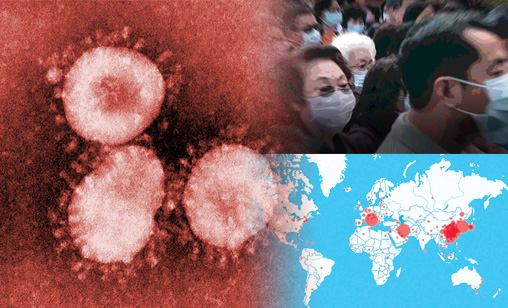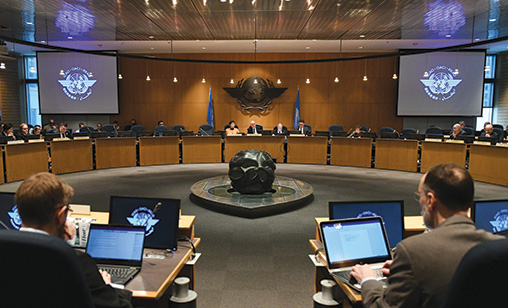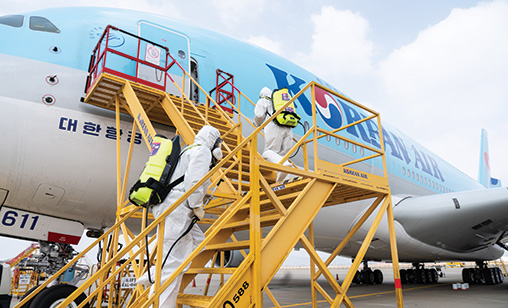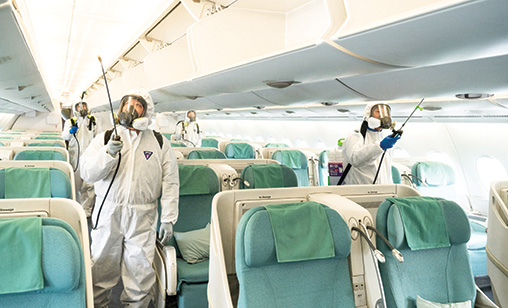Main Story
Dealing with the demon disease
Predictions of another profitable year for Asia-Pacific airlines have been torn up as the Novel Coronavirus outbreak, or COVID-19, is forecast to produce losses of up to US$57.3 billion at the region’s airlines. Associate editor and chief correspondent, Tom Ballantyne, reports.
March 1st 2020
As the coronavirus, COVID-19, spreads globally, battering airlines in the process, the International Air Transport Association (IATA) has taken the unusual step of asking global regulators to immediately suspend the rules of airport slot allocation for the entire 2020 cycle. Read More »
The importance of the campaign became clear at press time when the airline association upgraded its worst case scenario estimate of losses at the world’s airlines from COVID-19 at US$113 billion. Asia-Pacific carriers would suffer almost 50% of the figure in contracted revenues of $57.3 billion, IATA predicted.
 |
“IATA research has shown traffic has collapsed on key Asian routes. This is rippling through the air transport network globally even between countries without major outbreaks of COVID-19,” said IATA director general and CEO, Alexandre de Juniac, at the turn of the month.
“There are precedents for suspension of the slot use rules and we believe the circumstances again call for a suspension to be granted. We are calling for regulators worldwide to help the industry plan for today’s emergency and the future recovery of the network by suspending the slot use rules on a temporary basis,” he said.
Around 43% of all passengers depart from more than 200 slot coordinated airports around the world. At present, the rules for slot allocation require airlines to operate at least 80% of their allocated slots. Failure to comply results in the loss of an airline’s right to the slot for the next equivalent season. With thousands of flights being cancelled worldwide, dozens of carriers would not be able to comply with the rule.
De Juniac said the world is facing the huge challenges of preventing the spread of COVID-19 and keeping the global economy functioning. “Airlines are on the front line of that challenge. It is essential the regulatory community works with us to ensure airlines can operate in the most sustainable manner, both economically and environmentally, to alleviate the worst impacts of the crisis,” he said.
IATA made its appeal as airlines continued to slash capacity, cancel flights and ground aircraft across the Asia-Pacific to counter market conditions of collapsing demand and plummeting airline share prices.
In February, IATA forecast the region’s airlines faced potential losses of $27.8 billion in 2020 from the COVID-19 outbreak. By March 5, the association had forecast losses to the region’s airlines as high as $57.3 billion. Collectively, Australia, China, Japan, Malaysia, Singapore, South Korea, Thailand and Vietnam could lose up to $49.7 billion and the rest of the Asia-Pacific $7.6 billion.
At the time of writing, there were 101,000 plus diagnosed cases of COVID-19 worldwide, and rising, and more than 3,600 deaths.
Chinese airlines have been the worst victims of the virus outbreak, but airlines with significant business on and from the Mainland also are in crisis mode. The Hong Kong-headquartered Cathay Pacific group, already hard hit by eight months of civil unrest in the Special Administration Region, had parked 127 aircraft by the beginning of March and cancelled 75% of its flights for the month. Cathay said 25,000 of its 27,000 employees have taken up the company’s offer of unpaid leave.
Rival carrier, Hong Kong Airlines, is in near death mode as forced redundancies of more than 400 staff are activated, its feeder market from China has evaporated and commitments to loans falling due are not being met.
 |
Apart from airlines slicing through schedules to stay alive, every other sector of the travel industry is unraveling from lack of customers fearing infection outside the security of their homes. Mainland tourists into Hong Kong declined by 92% in January and came to a standstill when Hong Kong closed all borders except at the Hong Kong International Airport, the border crossing at the Hong Kong-Macau and Zhuhai Bridge and Shenzhen Bay.
Apart from the disappearance into thin air of Mainland tourists, a 93% decline in January, the local customers who kept Hong Kong’s hospitality and retail industries operating 24/7 also evaporated in the last week of January, retreating from their offices to work from home – with the encouragement of their employers.
In February, China’s Harbin Institute of Technology said COVID-19 had cost the Chinese economy US$505.07 billion since the outbreak began late last year. Of the first four tier cities in China – Beijing, Guangzhou, Shanghai and Shenzhen – the outbreak has had a minimum impact on the GDP of Shenzhen, the institute said.
Analysis of infection data and China residents’ intra-city trips in 200 cities revealed the infected number of people had a positive correlation with the per capita GDP of the city.
This meant, the researchers said, a Chinese city with higher average GDP per capita usually had more infected cases of the virus.
The World Health Organisation (WHO) has held back from declaring the crisis a pandemic, but several nations have ignored this advice and put emergency measures in place.
Most recently, Japan’s prime minister, Shinzo Abe, announced visitors arriving in Japan from South Korea, China, Hong Kong and Macau would be put under mandatory quarantine for 14 days after entry to the country. Japan is one of the most popular tourism destinations in the region, especially for Korean and Chinese citizens. The region’s LCC sector is expected to be especially hard hit by the Abe decision.
IATA said the bulk of the revenue depletion would be borne by Chinese carriers, with an estimated $12.8 billion lost in the China domestic airline market alone. The association had predicted three months ago that Asia-Pacific airlines were heading for US$6 billion in profits for 2020, a forecast now less attainable, although it is too early to accurately estimate COVID-19’s impact on eventual profitability.
“We don’t know exactly how the outbreak will develop and if it will follow the same profile as SARS (the Severe Acute Respiratory Syndrome pandemic which struck in 2003) or not,” said de Juniac.
IATA’s estimate of the damage COVID-19 will do assumed the centre of the public health emergency remained in China. “If it spreads more widely to Asia-Pacific markets then impacts on airlines from other regions would be larger,” de Juniac said.
 |
Such a situation is developing. The virus has spread to more than 80 countries and forward bookings are severely impacted beyond China. Korea also is hard hit with 25 countries placing restrictions for entry on Korean travelers.
IATA’s latest research revealed many carriers were reporting 50% no-shows across several markets and future bookings were softening. Carriers are reacting with measures such as crew taking unpaid leave, freezing of pay increases and scores of aircraft being parked. Leading by example, Singapore Airlines CEO, Goh Choon Phong, will take a 15% pay cut from this month.
“Given these extraordinary circumstances as a result of the public health emergency, the collective view of the airline industry is the application the 80% rule during the upcoming season is inappropriate. Flexibility is needed for airlines to adjust their schedules according to extraordinary demand developments,” IATA said.
Regulators have been waiving the slot rules on a rolling basis since the outbreak “Given the recent further outbreaks this is no longer contained to the Asia markets. Without certainty that these waivers will continue for the summer season (winter in the southern hemisphere), airlines are unable to plan ahead to ensure efficient rosters for crew and deployment of aircraft,” IATA said.
Suspending slot requirements for the entire season, to October 2020, would mean airlines could respond to market conditions with appropriate capacity levels, avoiding any need to run empty services to maintain slots. Aircraft could be reallocated to other routes or parked and crew could have certainty with their schedules,” IATA said.
OAG, a provider of digital flight information, intelligence and analytics, said China, previously the third largest international aviation market in the world, had fallen down the table to 25th by February 7, just behind Portugal and slightly ahead of Vietnam.
Since January 27, international capacity from China was reduced by 270,000 seats a week, an overall near 80% decline from an average previous weekly capacity of 1.7 million seats. But by the beginning of March, 2.9 million scheduled seats, or 18,200 flights, had been put back into the Chinese domestic market, positioning China as the second largest market in the world.
Elsewhere in the region, the impact of COVID-19 is accelerating. Korea has seen a 21% reduction in airline seat capacity and Hong Kong another 22% drop since January 20. Capacity has collapsed by 71% in the Hong Kong market alone.
The strength of the Japanese domestic market has provided a degree of protection to the locally based airlines. All Nippon Airways (ANA) capacity is down by 2.7% since January 20 and Japan Airlines by 5.3%. However, both airlines have made more cuts to their services in recent weeks.
Across the world major airlines such as British Airways, Lufthansa, Air Canada, all the big U.S. carriers and the Gulf airlines have cancelled or suspended hundreds of flights to and from the Asia-Pacific as passenger numbers tumbled.
For the region’s airlines, the health crisis is nothing short of disastrous, arriving as it has just after the damaging U.S.-China trade war had reached a partial resolution. The ban on Chinese travelers, who are vital to the tourism industry of many countries, has brought economic gloom to many countries.
 |
 |
Mainland visitors are the number one source of tourist arrivals in Thailand and Australia and high on the list in Korea, Malaysia, the Philippines and Japan. Bans against their travel removes billions of dollars from all sectors of the travel industry, including many airlines that have very large numbers of Chinese customers.
The International Civil Aviation Organization (ICAO) estimated Japan could lose $1.29 billion in tourism revenue, followed by Thailand at $1.15 billion, as a result of the coronavirus outbreak.
IATA’s grim outlook followed ICAO preliminary forecasts earlier in the month that in the first quarter of this year global airlines would record an overall reduction in passenger capacity of 39% to 41%, equivalent to 16.4 million passengers. This compared with a forecast of 19.6 million passengers for the period.
The decline equated to a potential reduction of $4 billion to $5 billion in gross operating revenue for airlines worldwide. ICAO said more than 70 airlines had cancelled all international flights to and from China and another 50 airlines had curtailed related air operations.
ICAO said COVID-19’s impact is expected to be greater than the SARS epidemic in 2003 in light of the higher volume and greater global extent of the flight cancellations this time around.
“Seasonal passenger load factors are another extenuating factor as is the fact China’s international air traffic has doubled, and its domestic traffic increased five-fold, since the 2003 period,” ICAO said.
In February, Qantas Airways Group CEO, Alan Joyce, said the carrier had made an underlying profit of $512.1 million in the first six months of its current year, but warned COVID-19 could cost it close to $100 million. He predicted weaker airlines in the region either would have to consolidate “or go out of business”.
A Singapore Airlines statement said: “Demand for services to Mainland China has been severely affected. The Parent Airline Company and SilkAir have drastically reduced frequencies on all Mainland China routes in February and March 2020, while Scoot has suspended all flights to Mainland China until March 28 2020, the end of the northern Winter 2019/20 operating season.”
Korea’s Asiana Airlines, already in financial trouble, has reduced 79% of its China routes and 25% of flights to Southeast Asian countries. Korea’s budget airlines, including Jeju Air, T’Way, Easter Jet, Air Seoul and Air Busan, all heavily dependent on Chinese traffic, have suspended flights to the Mainland.
Vietnam Airlines and LCC Vietjet, Indonesia’s Garuda and Lion Air also suspended all services to China.
Another casualty of the outbreak was Singapore’s biennial air show, which went ahead last month. Normally a big contributor to Singapore’s economy, more than 70 exhibitors withdrew at the last minute. The exhibitor dropout rate was shadowed by a decline in visitor numbers, especially from outside the region. They feared delays in returning home if flights were cancelled and they would be required to self-quarantine after returning from the region.
Speaking during the airshow, Boeing senior vice president of commercial global sales and marketing, Ihssane Mounir, said there was “no question” the outbreak would “hammer” the aviation industry and the broader economy.
“You have several global airlines that have limited their traffic in and out of China, that’s revenue. You have business trips not happening, you have cargo not going in and out. It will have an impact on the economy. It will have an impact on revenues. It will have an impact on these carriers. There’s no question about it,” he said.
Just how important China is to regional and global tourism and therefore airlines, is illustrated by GlobalData, a leading research and consulting company. Its director of Automotive and Travel & Tourism Consulting, Animesh Kumar, said the impact of the coronavirus outbreak is being felt by several countries across the globe, but it is likely to be severe in case of tourism-dependent countries across Southeast Asia.
“China accounted for about 12% (159 million) of global outbound travellers in 2019. The Chinese outbound market recorded the second highest spending in 2019, at $275 billion. The key destinations for China outbound travellers are Cambodia, Hong Kong, France, Japan, Macau, Malaysia, Singapore, South Korea, Taiwan, Thailand, Vietnam and the U.S. In all of these markets a big spending Chinese tourist has been hard to come by in recent months,” he said.
“The impact of the virus extends to China’s inbound tourism industry because so many airlines have cancelled their flights to China. The size of the inbound tourism market was more than $130 billion in 2019. The impact has been especially severe as the virus outbreak coincided with the peak holiday season, the Chinese Lunar new year.”
IATA said its estimates are based on a scenario where COVID-19 has a similar V-shaped impact on demand as experienced during SARS. It had a six-month period of sharp decline followed by an equally quick recovery. In 2003, SARS was responsible for a 5.1% fall in the RPKs carried by Asia-Pacific airlines.
The latest assessment of the impact of COVID-19 shows a potential 13% full-year loss in passenger demand for carriers in the region. Considering growth for the region’s airlines was forecast to be 4.8%, the net impact will be an 8.2% full-year contraction compared with 2019 demand levels, IATA said.
“We estimate global traffic will be reduced by 4.7% by the virus, which could more than offset the growth we previously forecast and cause the first overall decline in demand since the Global Financial Crisis of 2008-2009,” said de Juniac.
“Airlines are making difficult decisions to cut capacity and in some cases routes. Lower fuel costs will help offset some of the lost revenue. This will be a very tough year for airlines.”
De Juniac said airlines have developed standards and best practices linked to the International Health Regulations (IHR) to manage effectively and efficiently in times of public health emergencies.
“Airlines, therefore, depend on governments to follow the IHR so we have an effective global approach to containing the outbreak. We have learned a lot from previous outbreaks and that is reflected in the IHR. Governments need to follow it consistently. It is also important for governments to take leadership in shoring up their economies.
“The Singapore government, for example, is allocating S$112 million (US$80 million) to provide financial relief to airlines struggling to economically maintain connectivity. Airlines and governments are in this together.”